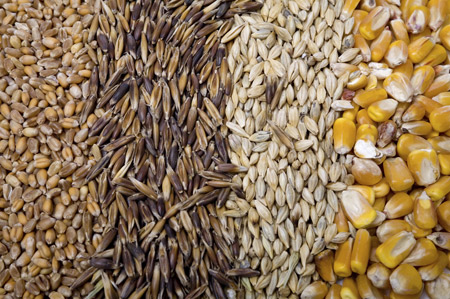 (Agrimoney) – Are we nearly there yet?
(Agrimoney) – Are we nearly there yet?
Selling in grains run out of steam, after notching up its latest set of four-year lows for futures, amid some ideas that the downside is no longer so large.
While investors were somewhat in liquidation mode, it was shares which were suffering in early deals, undermined by uncertainty created by military action in the Middle East, besides by soft eurozone purchasing managers’ index data, and some remaining uncertainty over China.
Major European stockmarket indices showed losses of 0.1-0.5% as of 09:45 UK time (03:45 Chicago time).
Grains, for which wars and political dislocations are, like or not, often supportive for prices, were broadly stable, with talk of producers backing off sales at low price levels, and futures approaching levels which are more consistent with the large production figures being talked about.
That said, with row crop harvest, typically a time of weak prices as supplies build, still in its early stage, there is little thought of a price floor definitely being reached yet.
Capitulation?
It helped that the dollar eased a touch, and indeed appears to have stabilised around four-year highs against a basket of currencies.
A stronger dollar undermines prices of dollar-denominated commodities by making them less affordable to buyers in other currencies.
But there is some idea that the latest leg downwards in prices spells the capitulation which can precede less dismal times.
“Lows usually come when the last person throws the towel in,” said Mike Mawdsley at Iowa-based broker Market 1.
“The thing I will watch for is where could this market bottom, or at least go sideways.”
‘Hint at finding a bottom’
“At this point I would think wheat would be the first to do so, then soybeans, and then corn,” he added.
And indeed, wheat after – in “some positive news” – failing to set a fresh four-year low in the last session, actually posted small gains in this one, adding 0.1% to $4.76 ¼ a bushel in Chicago for December delivery.
Benson Quinn Commodities said: “Selling by US producers in the spring wheat contract is drying up. I don’t get the impression the Canadian producer is providing a significant offer either.
“With the exception of EU milling wheat futures,” whose value has been put into question by loose delivery specifications, “global values hint at finding a bottom near current levels”.
Risk vs reward
For soybeans too, “downside objectives on short positions are now viewed modest at around $0.40 a bushel,” with a potential corrective rebound showing “a similar objective on the upside,” Benson Quinn Commodities said.
This more equal risk-reward pattern “may be triggering a touch of profit-taking after the market has tumbled near $3 a bushel over the past four months”, the broker said.
That said, it added the caveat “this does not imply the lows have been scored for the season but rather that the next leg lower will be a more drawn out slower grinding affair that sees selling coming from the producer rather than the speculative funds”.
And with the US row crop harvest likely to be a “drawn out” affair, as signalled by US Department of Agriculture crop progress data on Monday, it will be “difficult to probe long side” until perhaps November, said Richard Feltes at broker RJ O’Brien.
Palm gains
Still, for now, soybeans were dipping in and out of positive territory too, standing 0.5 cents lower at $9.35 ¾ a bushel for November delivery.
As an extra support for the oilseeds sector, palm oil for December added 0.9% to 2,144 ringgit a tonne in Kuala Lumpur, earlier touching its 50-day moving average (on a continuous chart) for only the second time in six months.
The vegetable oil is being supported ideas of demand at prices still not too far from five-year lows, with importer Ruhi Soya saying India’s purchases of edible oils could hit a record 13m tonnes in the year starting in November, of which 9m tonnes will be palm oil.
For 2013-14, total edible oil imports are seen at 11.6m tonnes, including 8m tonnes of palm oil.
Furthermore, in terms of output, the Malaysian Palm Oil Association producers’ group estimated Malaysian volumes down 12.2% in the first 20 days of September, suggesting potentially that the seasonal peak was reached early, in August.
Sowings debate
Back in Chicago, even corn managed to baulk at further losses, after coming in the last session within an ace of a five-year low.
The debate in fact continues over US harvested acreage, particularly of corn, but of soybeans too, after Farm Service Agency data last week showed a big gap between the sowings area as gleaned from farmer filing and the bigger figure from USDA estimates.
While the data are open to a large amount of interpretation, Michael Cordonnier, the respected crop scout, gave the lower-acreage camp a boost by, according to sources, pegging US corn sowings 2m acres below the USDA figure, and soybean plantings 1m acres below.
‘No incentive’
Still, not all investors are so convinced.
Darrell Holaday at Country Futures, for instance, attributes the void in the data merely to delays in farmers filing their crop acreages.
“One big difference between this year and previous years is that there is no farm programme to sign-up for and will not be one until January 2015,” he said.
“Therefore, there is no incentive for certifying acreage with the FSA office on time.
“As point of fact there is no penalty. One can certify acreage in December and sign up for the programme in January and there are no issues.”
Whatever, corn for December stood 0.25 cents higher at $3.25 ¾ a bushel, looking for its first winning session in six.




